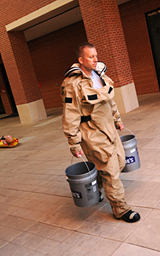Getting the Boots
For wading around near a chemical spill, most firefighters wear rubber boots. Unhappily.
While rubber boots can be decontaminated, they’re often slippery and uncomfortable, leaving first responders longing for leather boots. The problem, of course, is that leather absorbs liquids.

Dr. Roger Barker wants to combine the best of both boots, using new textile materials and surface treatments to make leather boots that can be used for fighting fires and responding to HazMat calls.
“We’ve been exploring options like providing a finish to the leather that would reduce chemical absorption while making it easy to clean and decontaminate,” Barker says. “So we’re not just creating a leather HazMat boot, we’re also designing a simple cleaning method.”
The Department of Defense is supporting the research at the Textile Protection and Comfort Center with an $800,000 homeland security grant.
Firefighters are putting prototype boots through their paces, checking comfort, ergonomics, traction and stability as they climb stairs and perform simulated rescues.
Independent laboratories will evaluate and certify a final prototype to National Fire Protection Association standards so that companies can bring it to market.
- Categories:


